Introduction
This is an abridged description of a roundtrip through Nepal (see map below) commencing October 1992. The intention is to give a firsthand personal experience of how we, Brigitte and I, did get to and through the country. Despite the fact that we did not book anything in advance at all (except for the flight to Kathmandu) and that we covered around 800km within the country during the 13 days, it was no problem getting any means of transport (with one or two days advanced booking for domestic flights) or accommodation on the same day. I only did some kind of pre-planning in so far that we wanted to have enough time to visit Sikkim and part of East India (see next travel report), also because our return flight was starting from Calcutta.
At the time of writing all this, more than 17 years have passed and I tried to recall as much as possible with a little help from my Lonely Planet guidebook. What I had seen and experienced, may not be the way today anymore, though culture and customs however does not change much in this very religious country but the political situation.
I still remember the reason for choosing this destination. I suggested Rajasthan in India but Brigitte wanted to go to Nepal, because she heard about the beautiful landscape and supposedly clean and clear air in Nepal like in Switzerland not knowing at that time that Kathmandu was the third worst air polluted city in the world right after Mexico City and Santiago de Chile.
Actually, I wanted to find out how she will manage to survive a backpacker trip to a third world country, since this was her first one. I thought that surviving Calcutta would be a good test. But just the contrary. She didn't need Mother Theresa but she did get Asthma in Nepal again after many years with no symptoms: Not seeing Calcutta and die, but going to Kathmandu and suffocate (more on that later on).
Sometimes, I slip into a writing habit:
It's like a tic,
I can't help it.
If you won't read it,
then just leave it
and take the liberty
to skip my silly poetry.
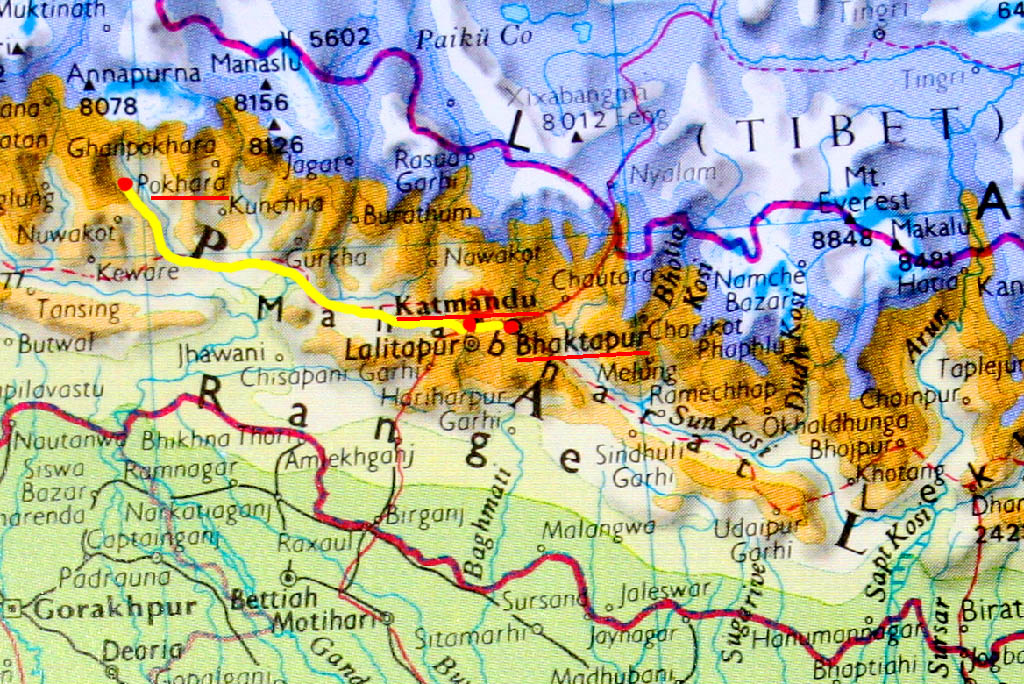
Getting from Germany to Kathmandu
We had a round trip ticket of Biman Airways (the national airline of Bangladesh) from Frankfurt to Kathmandu and return from Calcutta and did cost 1,325 DM (around 665 Euro today) per person. That was the cheapest fare we could get at that time, so was the service on the planes and in the transfer airport in Dhaka.
Kathmandu
As soon as we landed at the airport in Kathmandu we had to go through a lengthy visa procedure (had to handle it for both of us). As soon as we stepped out into the arrival hall we were surrounded by a bunch of boys trying to lure us to all kinds of accommodations. We told them that we wanted to stay in the
which was supposed to be the best backpacker place and best value for money in town, according to our guidebook. We accepted the offer of a driver to bring us there for free (so the commission must be good). But the guy brought us to another guest house of the same name (all on purpose to participate from the image of the original one). We soon found that out and wanted to move out next day. But we were offered another guesthouse in the countryside instead (still with walking distance to the city), which we took after a look and the view was good.
Our first sight-seeing walk, of course, was then into the real center, which was in and around Durbar Square. Durbar means palace so was the old palace just in front with many temples around.
Click the small picture to get it enlarged
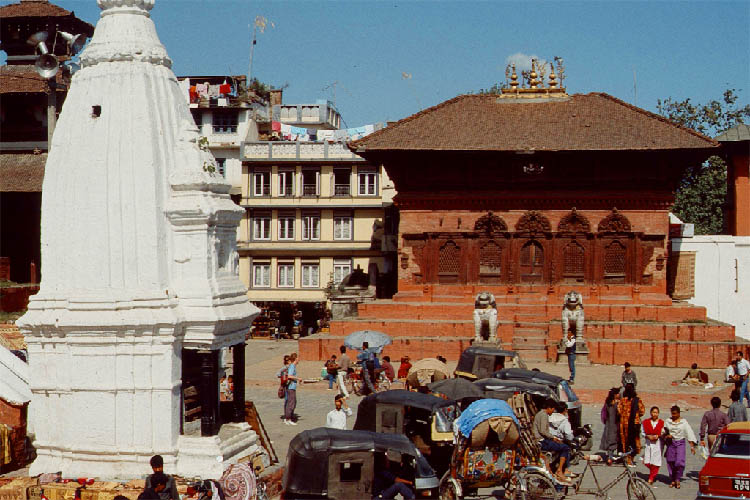
| This is the Durbar square
|
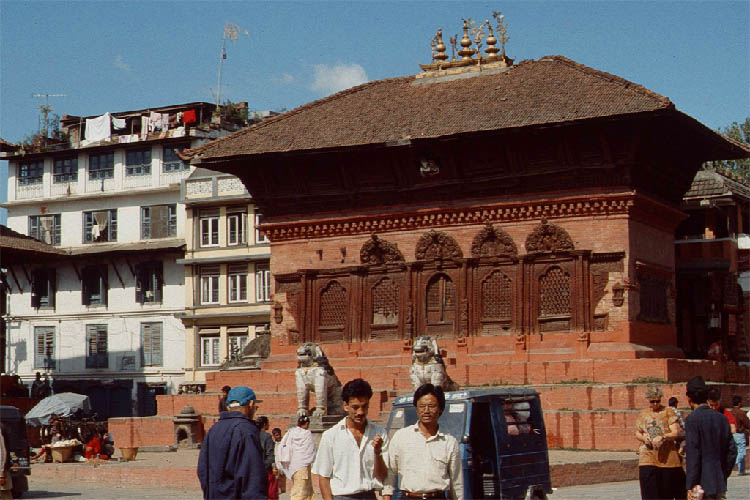
| which many temples share
|
Each temple, of course, has a different name and is devoted to one or various gods. It will be too much now to name and explain all including their religious background. The Nepalese are mostly Hindus. Next comes Buddhism (Buddha was supposed to be born in Nepal). There also ought to be some Muslims around, but we didn't see any.
We rather enjoyed looking at the architecture and the busy life around. We had our own contemplations while sitting and relaxing on the steps of the Shiva Parvati Temple in the middle of the Durbar Square, for example.
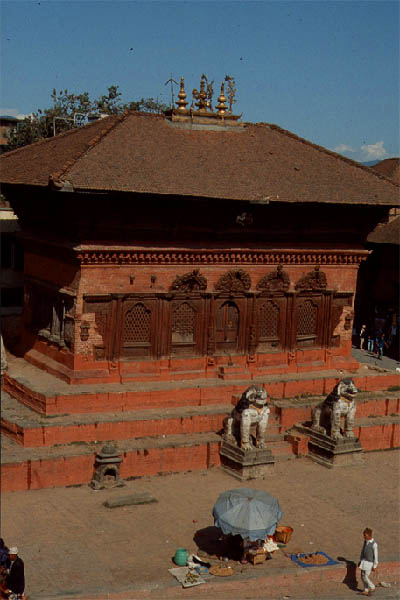
| The vendors around are very keen
|
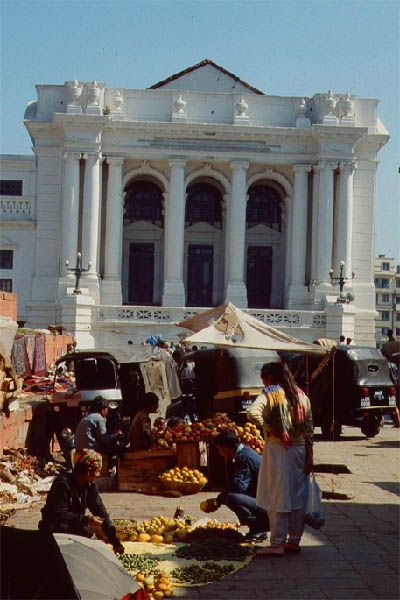
| Even a market is located in between
|
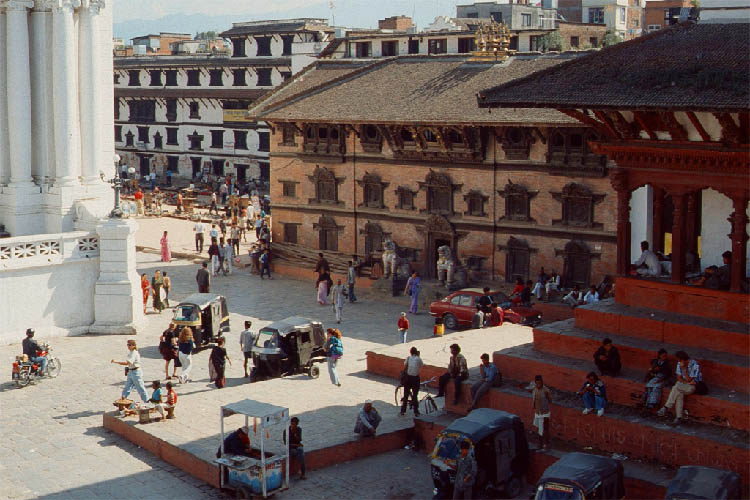
| Vendors are waiting for potential buyers
|

| A Saddhu on the way to the morning prayers?
|
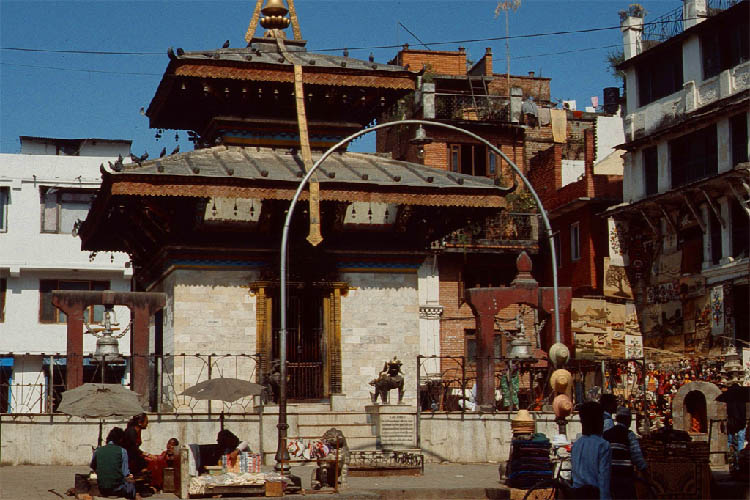
| Temples are around a lot
|
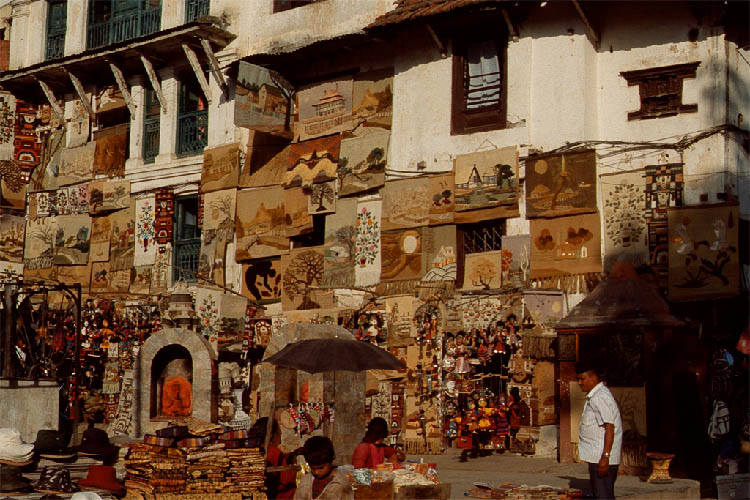
| Just beside is a souvenir shop
|
Women were not allowed to freely move around and shop in public in the old days. Mostly they had to stay in the house but were allowed to look out the beautifully carved windows without being seen themselves, because of the meshwork.
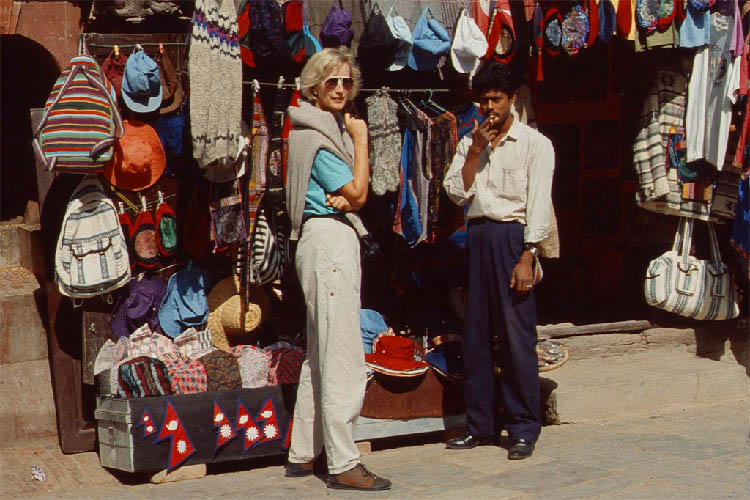
| Women now can freely shop
|

| Not only watching from the top
|
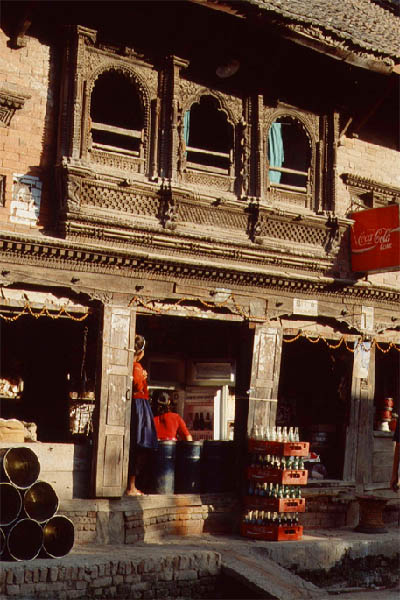
| A woman actually shouldn't show her face
|
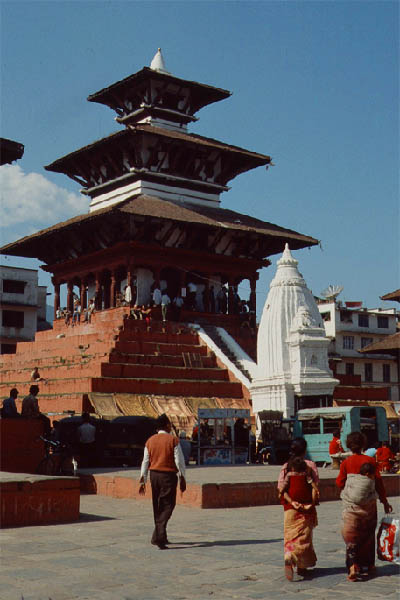
| Women today still carry their babies the old ways
|
Our first impression of Nepal was overwhelming. And the clear sunny sky implied unpolluted air, so it seemed during our first sight-seeing tour in the small streets, into courtyards and over the squares in the middle of Kathmandu. The few photos should be proof. I could have shot a lot more but I couldn't compete with the quality of the glossy colorful photos in some of the picture books for sale.
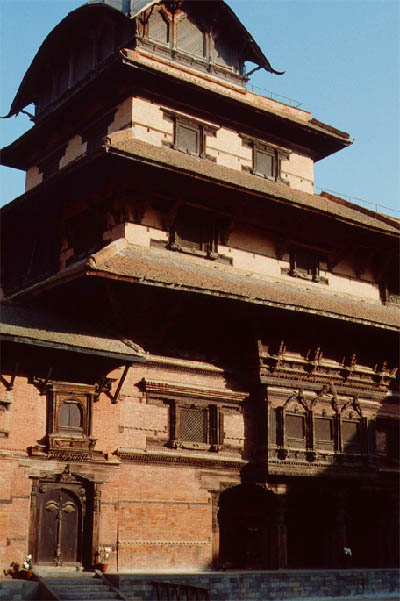
| At every corner is another temple
|
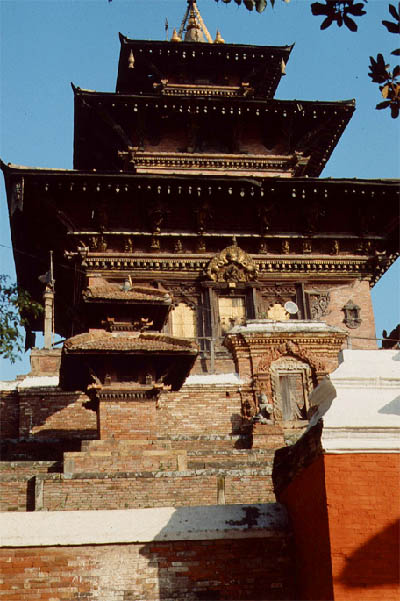
| Every one is another good example
|
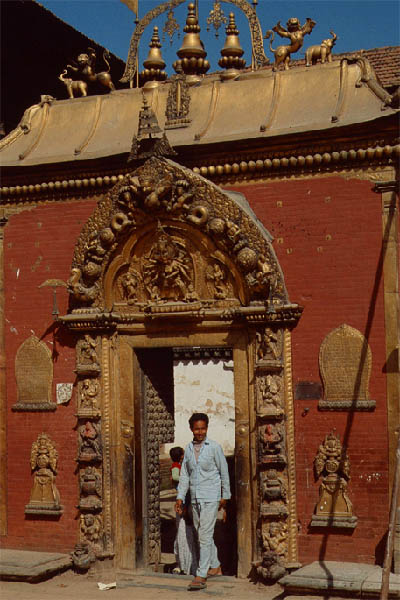
| May we go through the gate?
|

| May we have a look inside
|
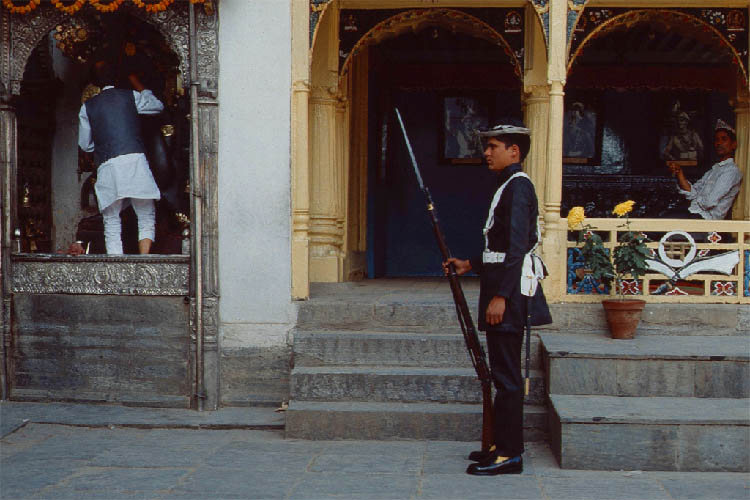
| The old palace is protected by a guard
|
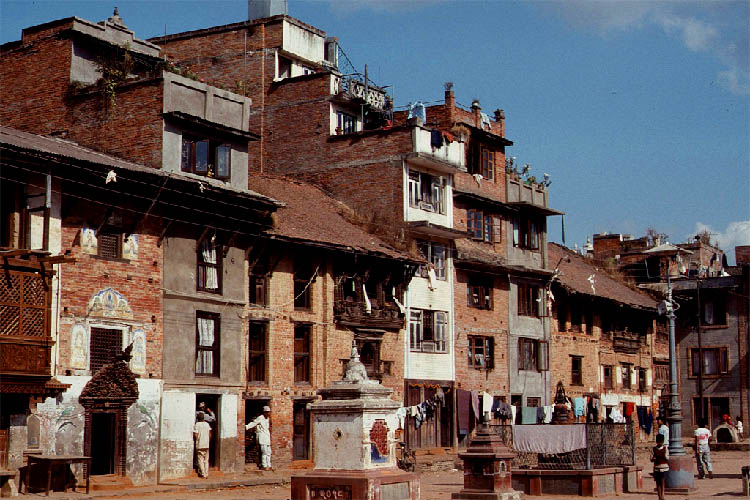
| Behind normal houses is a nice court yard
|
Around Kathmandu
From our guesthouse we saw a stupa with a golden roof glistening in the sun. That must be Swayambhunath, a Buddhist temple complex, also known as the monkey temple.
We decided to take a walk to get there over the river and then through the forest and up the hill always looking for and into Buddha's eyes painted on all for corners of the stupa.
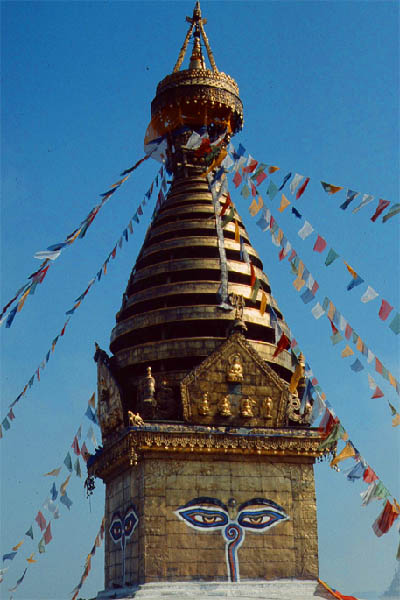
| From far away we saw this stupa
|
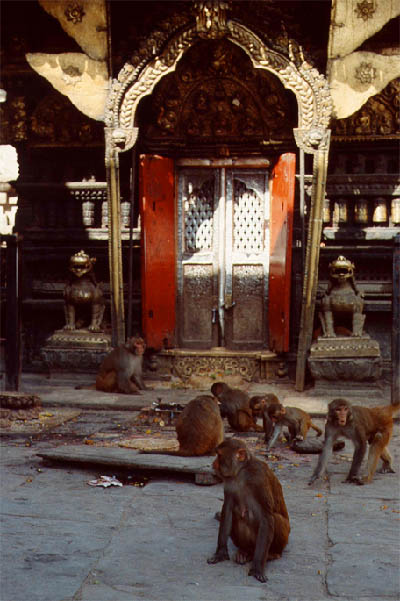
| When we got there, the temple was super
|
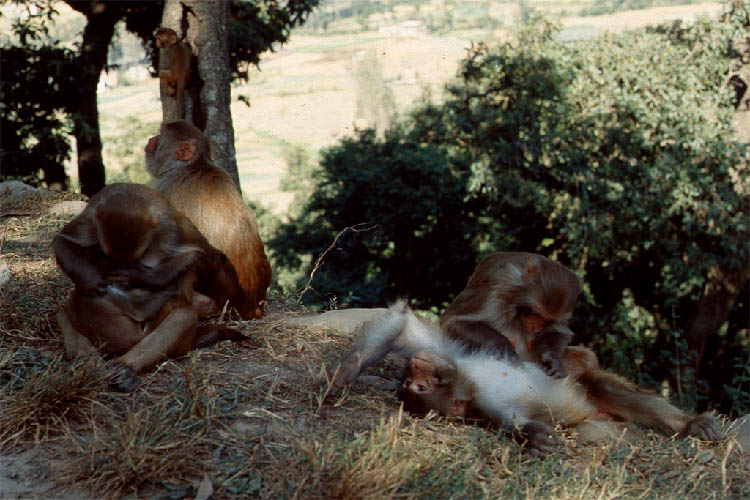
| They must have been holy, the monkeys
|
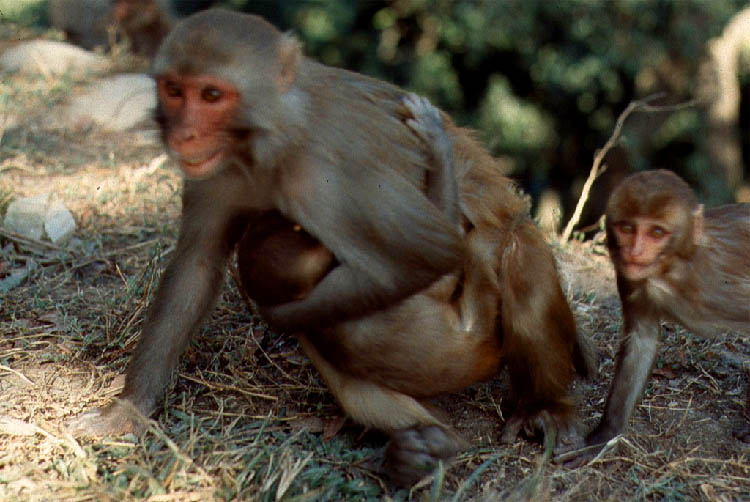
| Because they roamed around like monks
|
On the way back down and across the river we encountered a funeral procession. But that seemed to be a cheap one, because there were no ghats and temples (as in Pashupatinath described later on), but only the riverbank to be used as the cremation site.
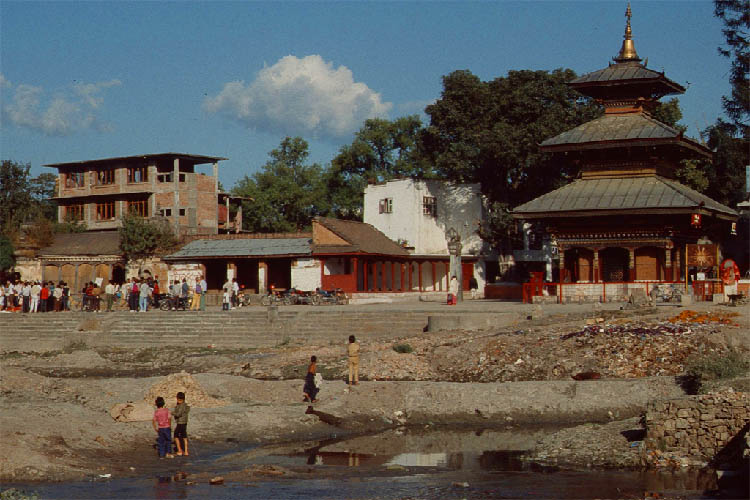
| Down by the riverside
|
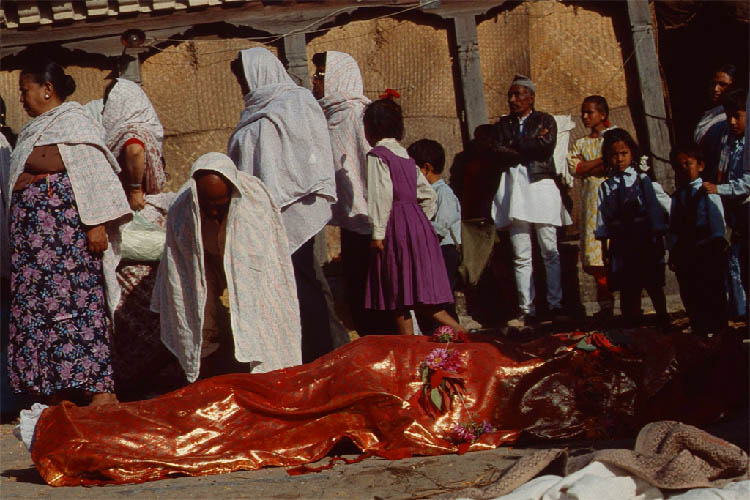
| was a cremation site
|
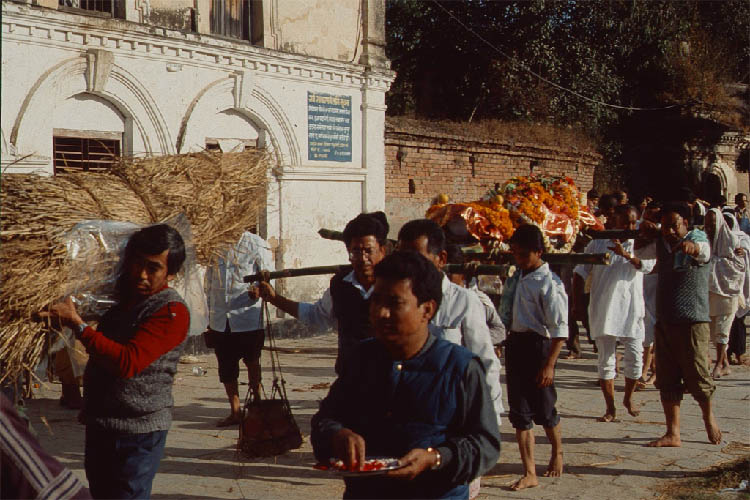
| The procession leads to a pyre
|

| where the body will be put on fire
|
Then we had to cross farmland and pass farmhouses to get back to our guesthouse and get ready for dinner at one of the many restaurants. But which one? There are all kinds of cuisine. But no foreigner was allowed to work as a cook, because all these jobs were reserved for locals only. So the Italian pizza or pasta was not so classica.
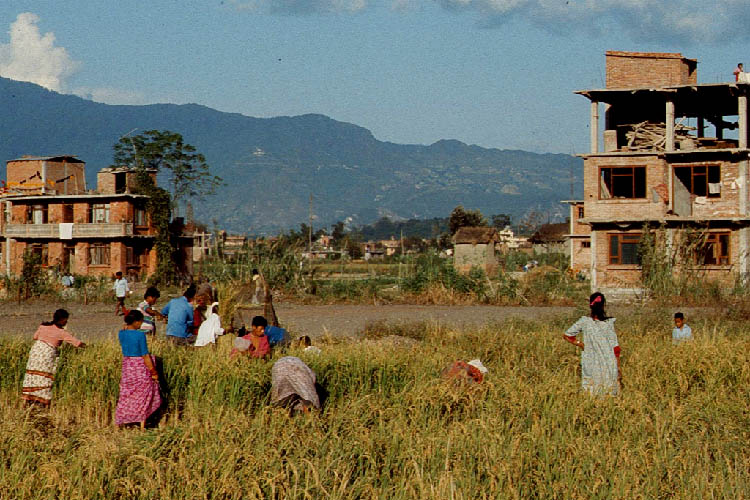
| People are harvesting rice
|

| The main staple to survive
|
Bicycling Tour to Bhaktapur
We decided to leave the other sights of Kathmandu for a later time. Next we wanted to visit another famous site outside. To get there we rented bikes to bicycle through the countryside to Bhaktapur, located only 16km from Kathmandu. But the ride was not so nice. Instead of breathing the clean fresh country air we had to inhale the black exhaust gases every time a bus or truck overtook us. There was no way to leave the road, not even with our mountain bikes.
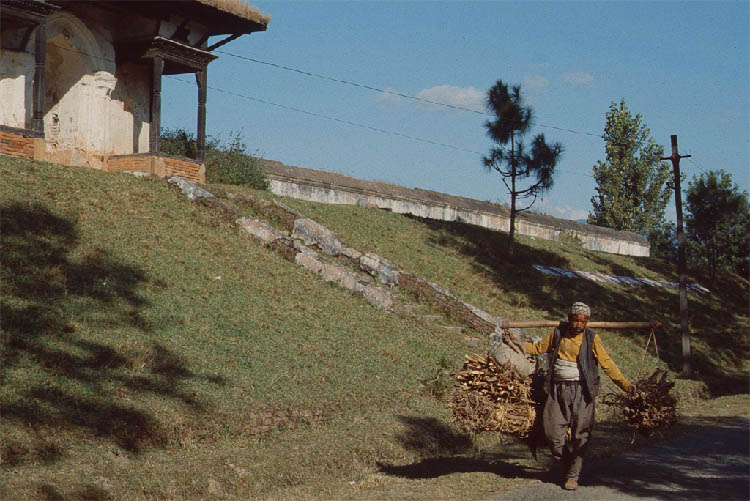
| Instead of walking through the countryside
|
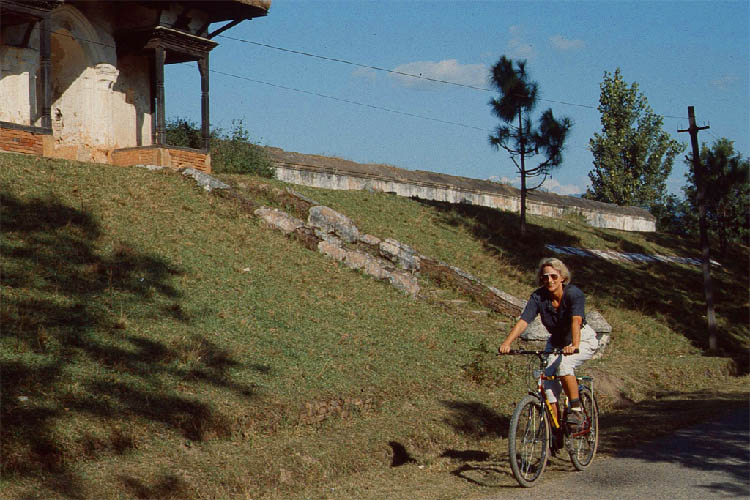
| Each of us rented a mountain bike
|
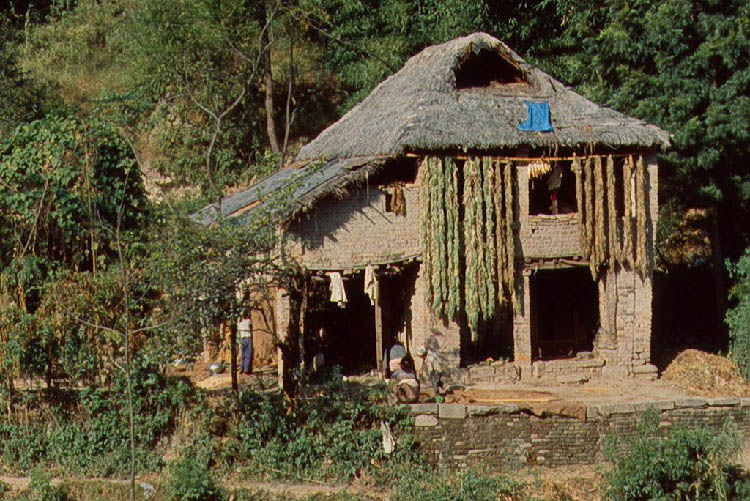
| We saw nice houses at the side
|
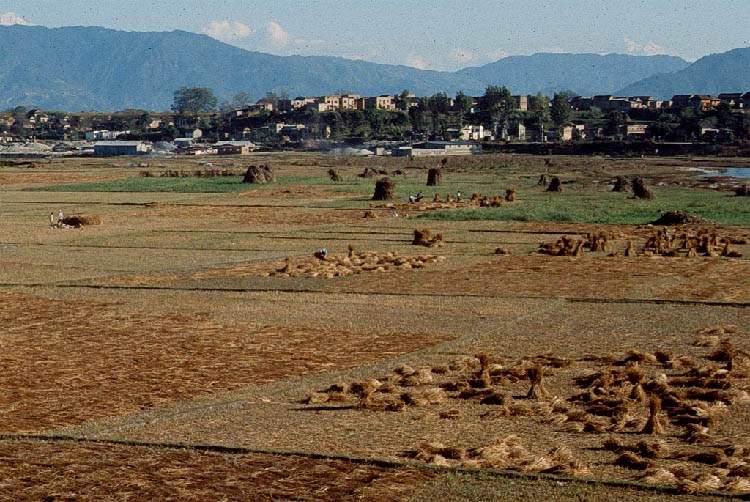
| But there was no off-road to ride
|
So we arrived in Bhaktapur exhausted from the exhaust. We had to leave the bikes outside the wall. Boys offered us to watch them for a fee. Yes, we trusted them. And it was beautiful within the wall with many temples and also a Durbar square, because this place became another king's capital more than thousand years ago.
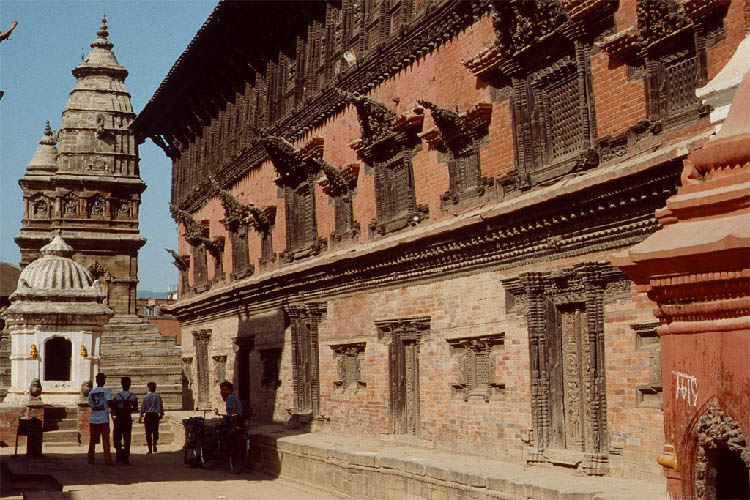
| Then we came to another king's town
|
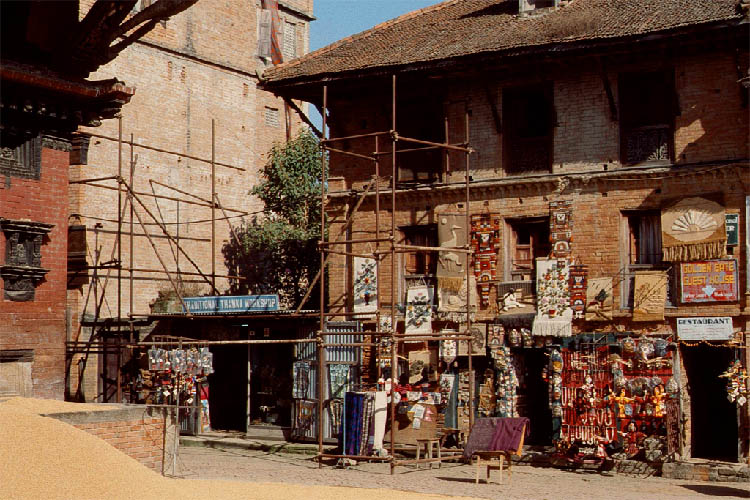
| With also souvenir shops around
|
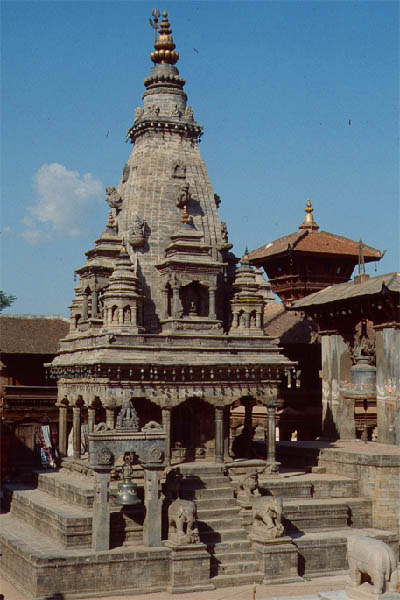
| This Vatsala Durga Temple is very famous
|

| It's really a nice work of the stonemasons
|
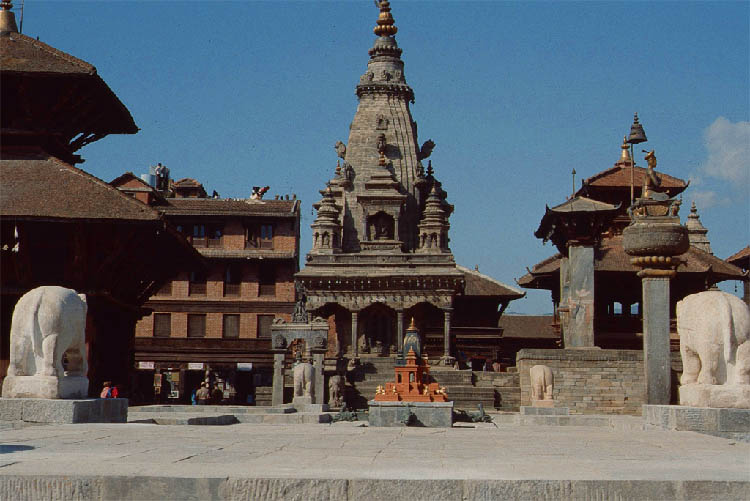
| Wandering around this place was also a little exhausting
|
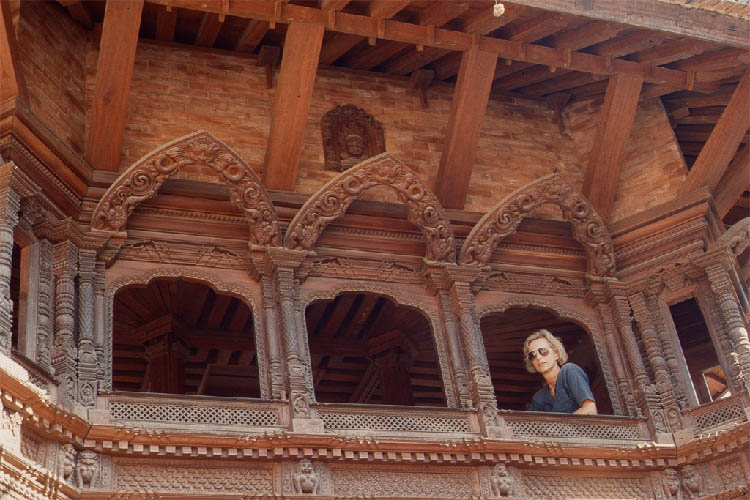
| Though, sitting down and look out the window was very relaxing
|
There was a lot more to see in and around Kathmandu but we decided to leave it for the time being and go on a trip to Pokhara next.
Pokhara
The bus ride to Pokhara was adventurous. It took almost the whole day for the 250km. But we were awarded with a beautiful landscape and finally the picturesque shore of the Phewa Lake with a view to the snow capped peaks around eight-thousand meters high.
But Brigitte couldn't enjoy all that very much because she became ill and had to lie in bed. Did she catch a virus in Kathmandu? Was the bus ride too drafty and strenuous? It couldn't be the altitude because Pokhara's elevation was only 880m, even less than Kathmandu with 1220m. Or was it already an asthma condition revived by the air pollution in the Kathmandu Valley?
Whatever it was, it did get a little better after three days or so. But joining a guided four days Anapurna Skyline trek was out of the question now, not to mention doing the whole Anapurna Circuit. We rather did another circuit: Climbing up the hill from the east (where the Binde Basini Temple stands) to the west, passing the village of Sarangkot (1592m), then walking down to lake Phewa, where we hired a boat to bring us back to Pokhara.

| Walking up a hill very steep
|
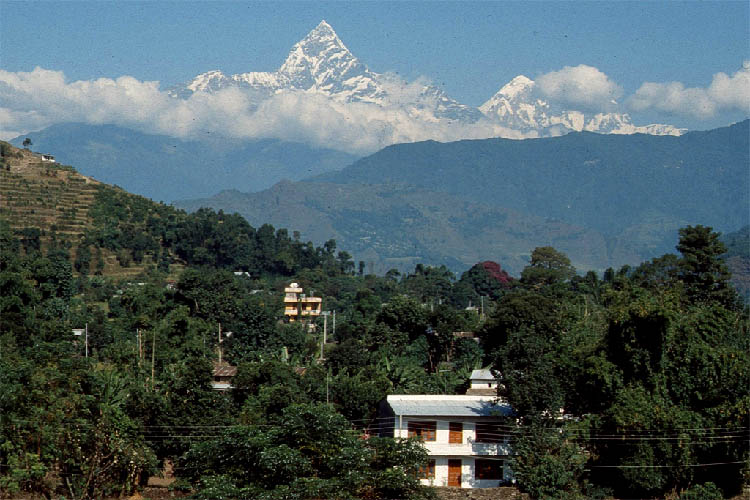
| To admire the Machha-puchhare peak
|
The mountain skyline with the peaks of Machhapuchhare shown again on the following left picture and then the Anapurna III on the right was fantastic. There are actually five Anapurna peaks. Anapurna I is the highest with 8091m. The Machhapuchhare is "only" 6993m high but really looks more impressive with its perfect cone.
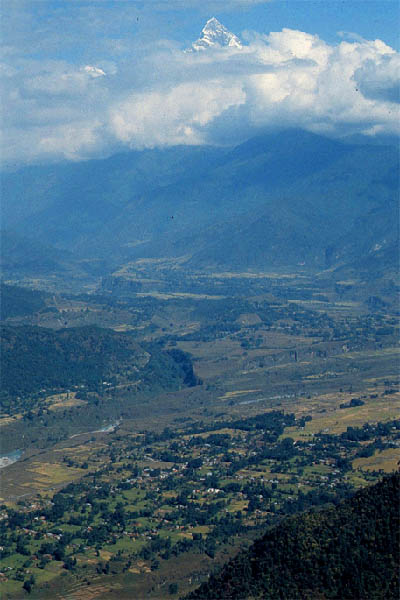
| The high mountains far up and away
|
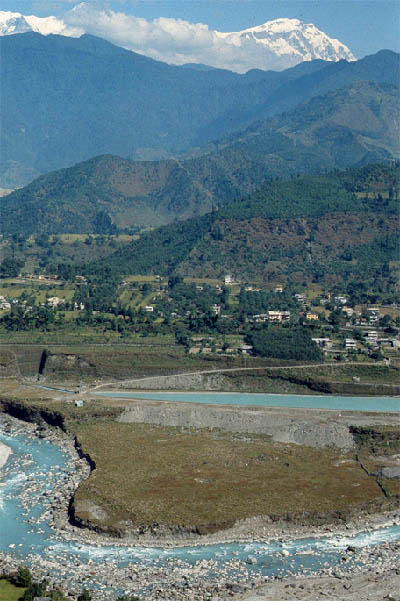
| A beautiful landscape down there
|
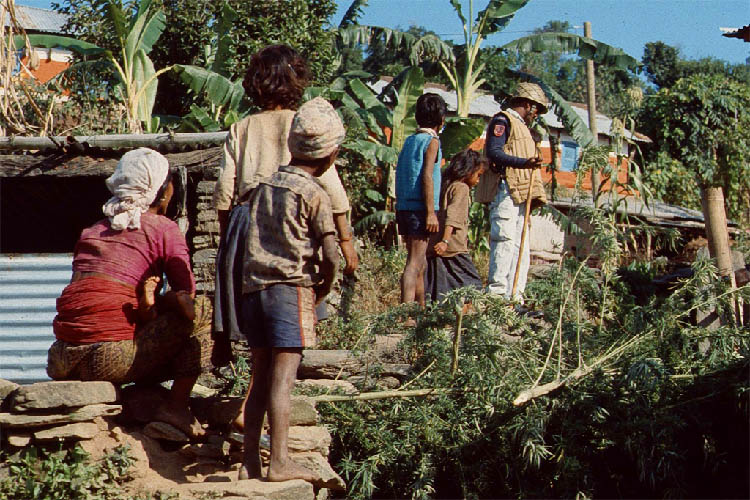
| What a pity that Marijuana is being confiscated
|
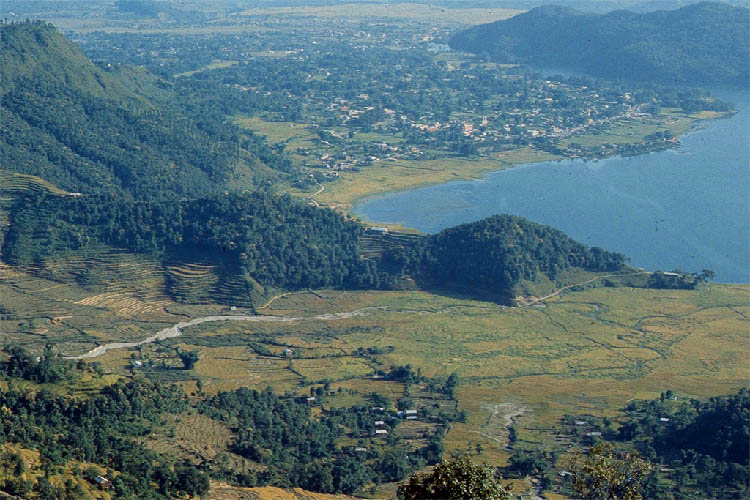
| The view down to the lake with Pokhara is first class rated
|

| Crossing the lake
|

| Relaxing at the lake
|
We met a guy who just did the Anapurna Circuit, a trek not on top but all the way around Anapurna. He told us that it was very hard, especially getting over the highest pass with around 5500m. But actually, any healthy person should be able to do it.
Ok, maybe we consider it next time we come here. But for now we had to leave this nice place and get back to Kathmandu. Instead of looking at the peaks from below we now could see them from above, i.e. from the plane flying back to Kathmandu.
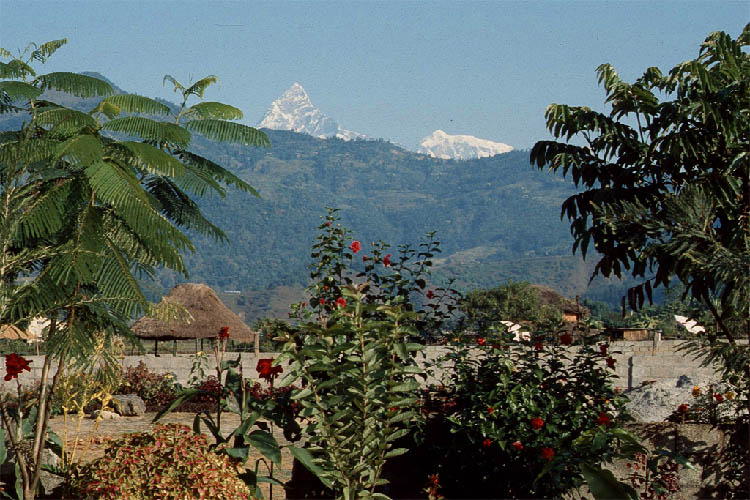
| Last view to Machha-puchhare with a perfect shape
|

| Climbing to the top of Mount Everest I will never make
|
Back in Kathmandu
The flight back to Kathmandu with the Royal Nepal Airline was very smooth with a very clear and fantastic sight of the Himalayas. As soon as we arrived at the Kathmandu airport we knew again where to stay. But this time there was no fake hotel with the same name: the
It was listed in my guidebook and I also overheard a conversation during the flight from Dhakka appraising just this place. I am actually not fond of a luxury overnight stay (by not losing touch with other backpackers) but this time it was different and we needed a better environment and service since Brigitte still had to recuperate from her sickness.
I think it was the best hotel in Kathmandu and we were lucky to get the last available room beside the restaurant, and that for 50 USD only.
The "Village" consists of several traditional houses built with a lot of renovated material salvaged from old Nepalese houses being torn down.
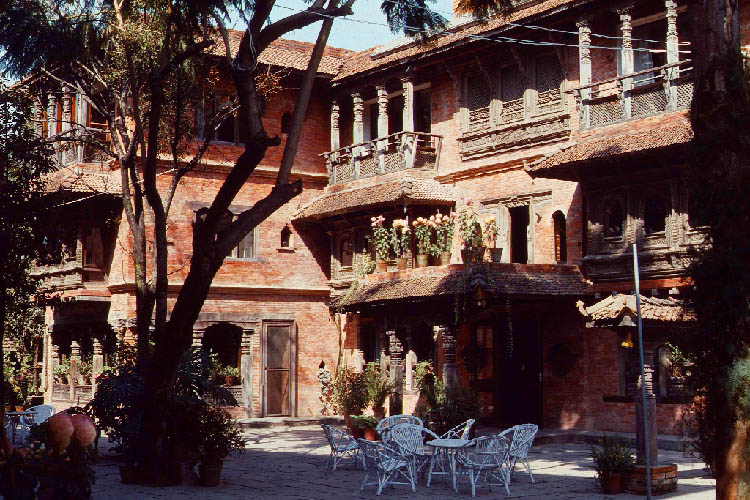
| This hotel is the best
|
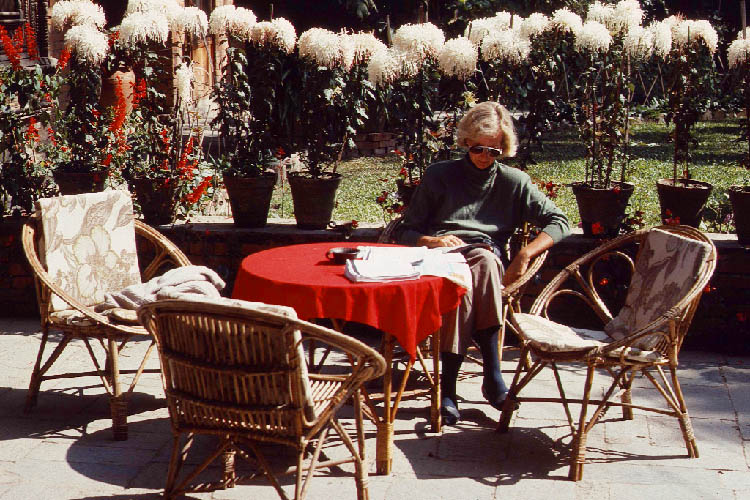
| A really nice place to rest
|
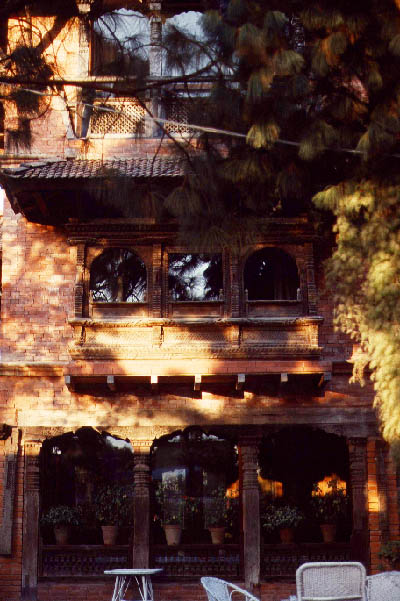
| Sleeping in a nice building like that
|
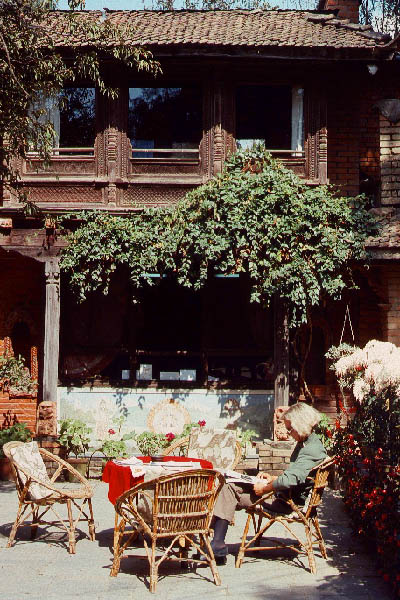
| In the garden having a good breakfast
|
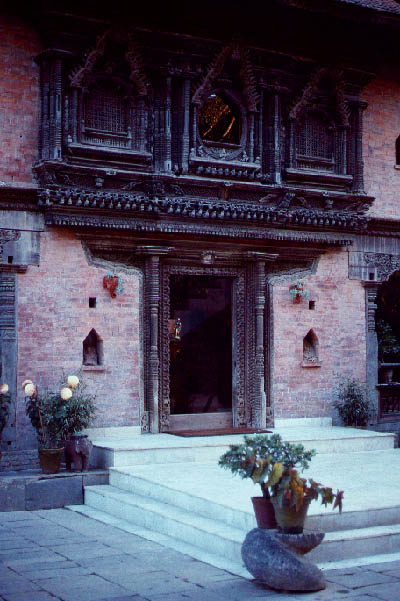
| The design of the buildings is fantastique
|
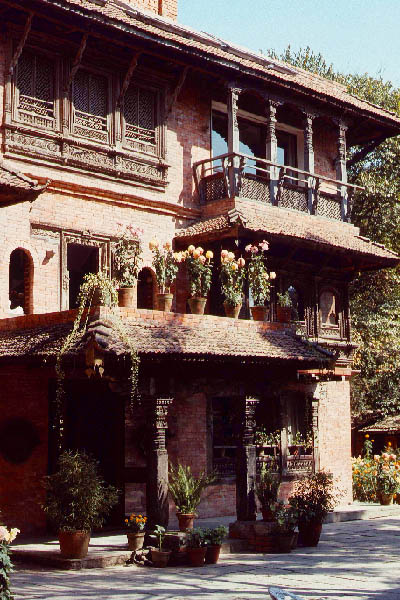
| The materials used are really antique
|
The owner of this place was a well known politician in Nepal. Yes, he was, because he died recently. His daughter, married to a German and half living in Germany, has taken over the hotel and managed it for the time being.
This hotel was very closely located to Pashupatinath at the Baghmati River with many ghats on the riverbank where the cremations are taking place, almost as famous as at the Ganges in Varanasi in India.
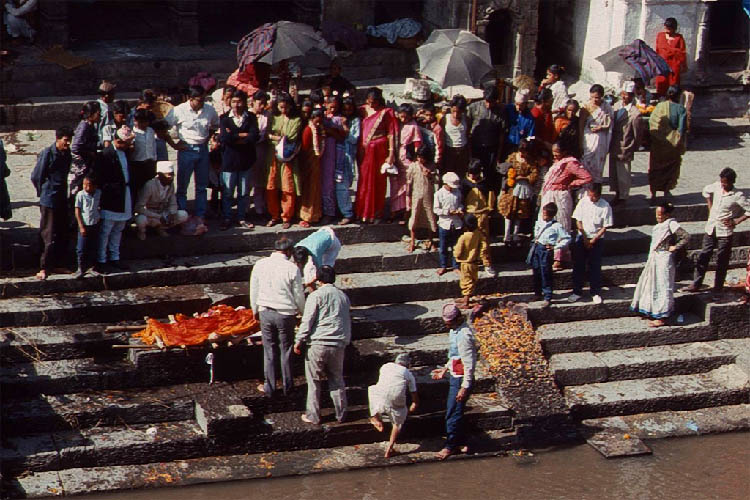
| A funeral celebration is still going on
|
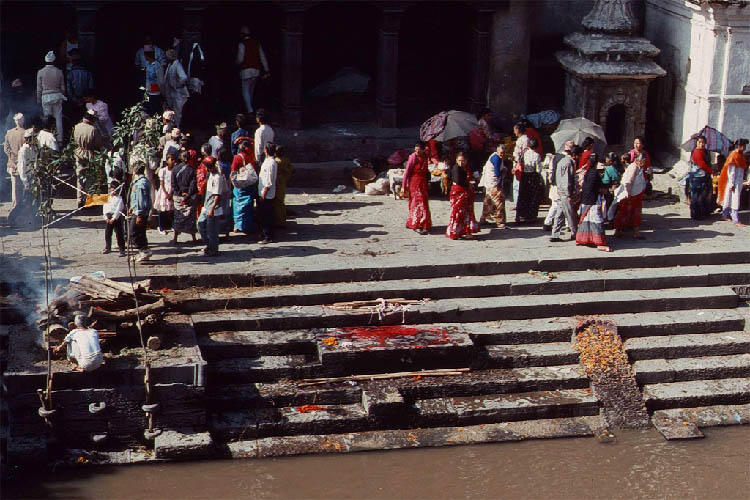
| As soon as the body burns, the people are gone
|
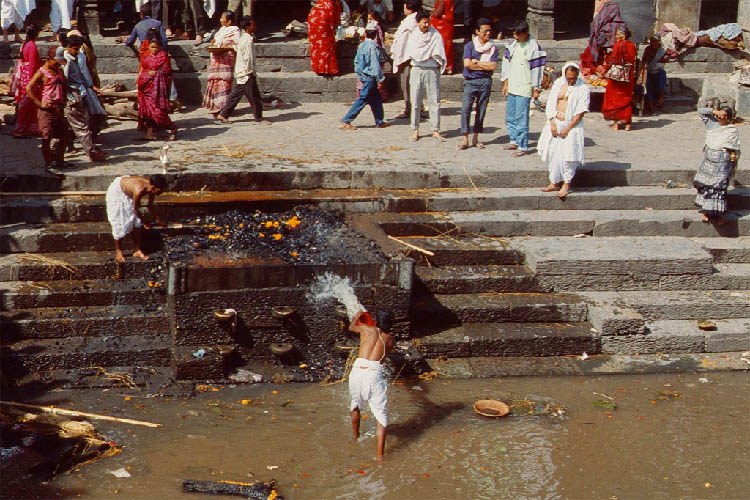
| All remains and ashes swept into the river
|
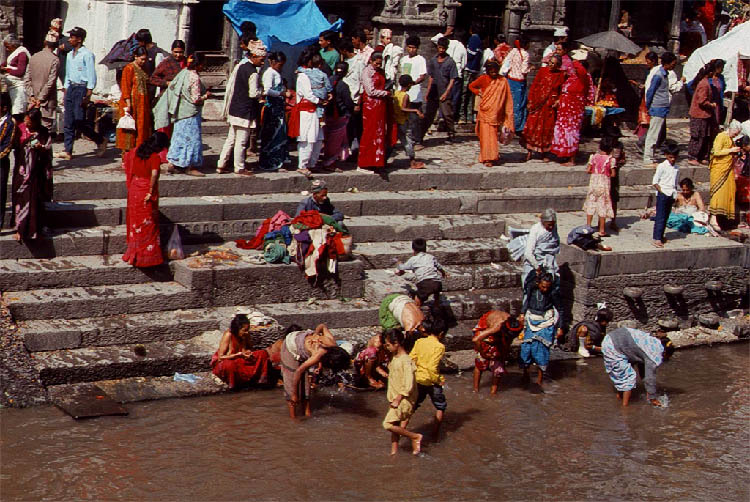
| People bathing in the same water, I must shiver
|
Part of the whole complex is also a famous and most sacred Hindu Temple. Many people from all over India are coming here to pray, too. The inside of the temple is off-limit for non-Hindus.
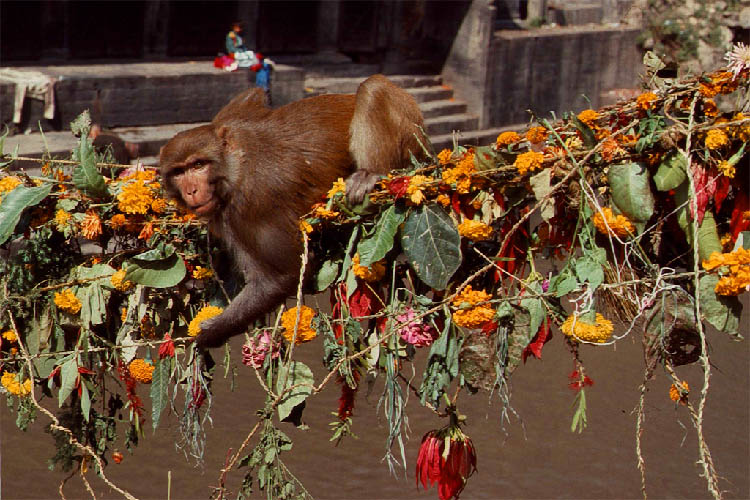
| Monkeys eating flowers, who cares
|
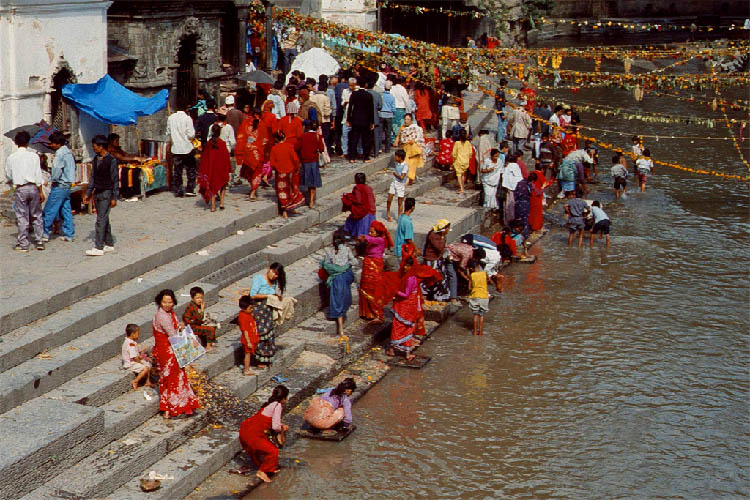
| While people are gathering on the stairs
|
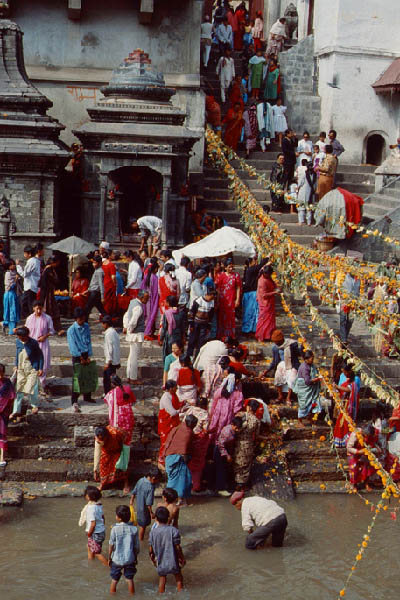
| What do people after the funeral or the bath:
|
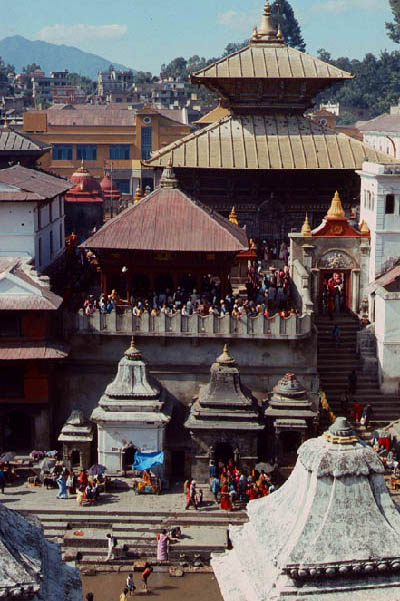
| Worshipping in the temple of Pashupatinath
|
The ghats on one side of the bridge are for the rich and the other one for the poor. It all depends on what the family of the deceased can afford to pay for the service. Some even must choose a plain riverbank for their cremation like you have already seen at the beginning of this report.
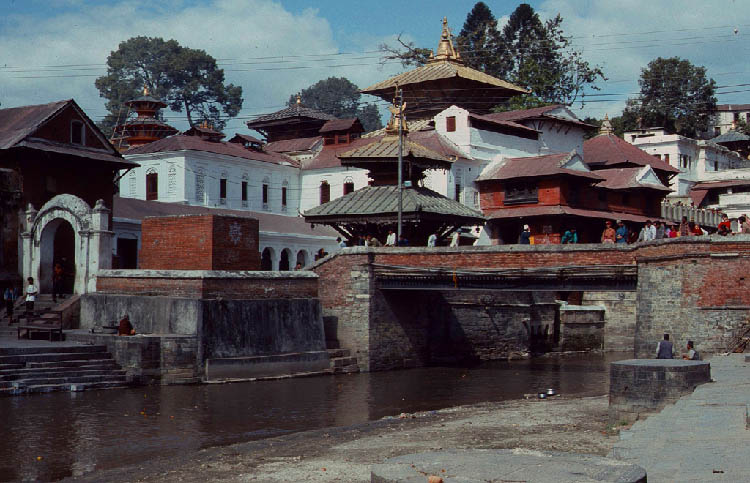
| On the left of the bridge are the ghats for the poor
|
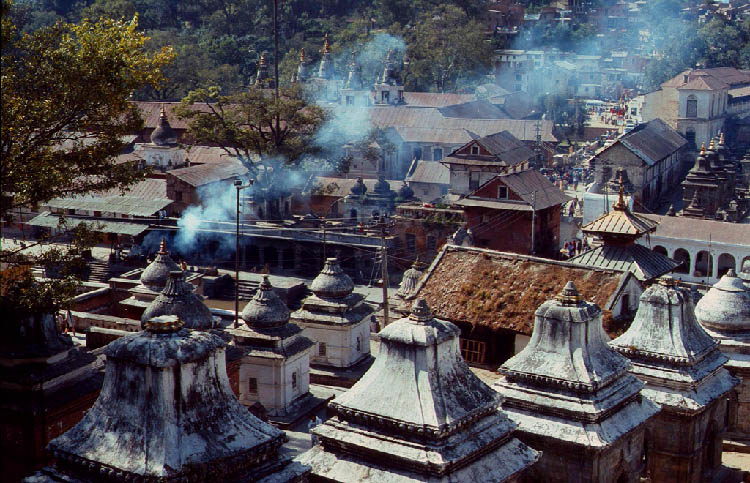
| The stony shrines contain lingams but I am not sure
|
Opposite the riverbank with the ghats is another complex leading up the hill with many little stone shrines. From here you have a nice view down to where the action is.

| This place is really the best
|
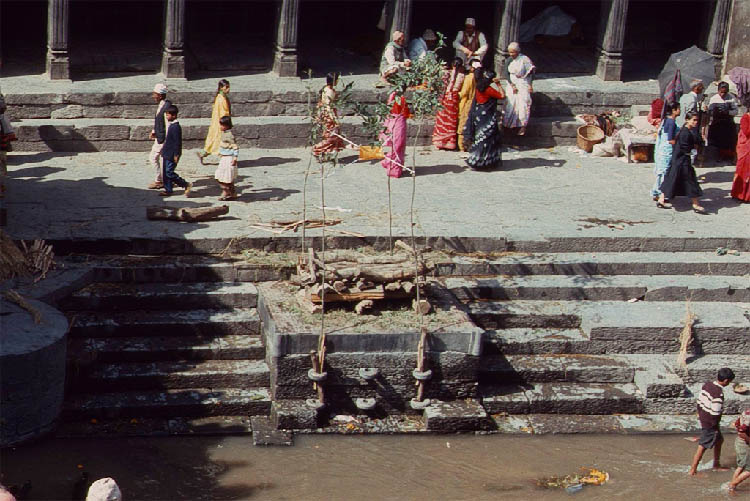
| to watch the funeral coming next
|
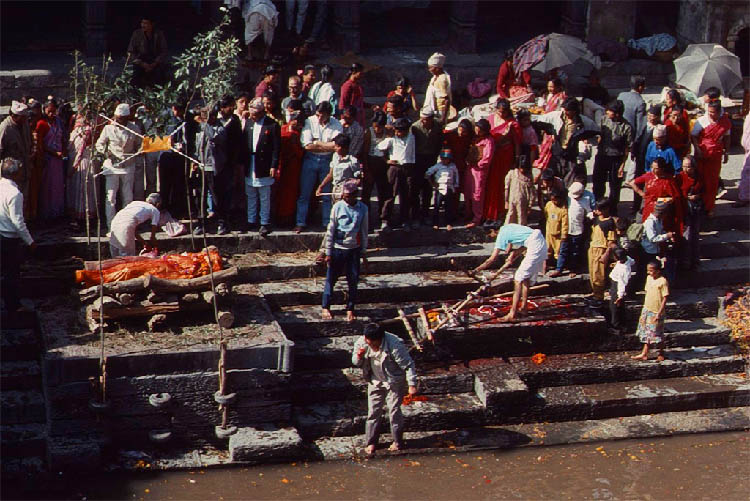
| Another funeral is going on
|

| Then again the corpse is gone
|
The immersion of the remains of the cremated body in the sacred water supposedly cleanses a Hindu of all their sins (bad guys will thus get away with murder?).
Brigitte didn't need (yet) sin cleansing but lung cleansing right now. Yes, mostly the sky looks blue around Kathmandu, but smoke particles from the cremations and fires for cooking and bonfires and last not least the fumes from old buses and trucks in the valley of Kathmandu were everywhere not able to escape over the surrounding mountains. This valley of only 30km in diameter is also the most densely populated area in Nepal.
So Brigitte still didn't feel well. The lady from the Dwarika's Village Hotel was very helpful and advised to go to the CIWEC, an American hospital serving mainly Westerners (locals could hardly afford the fees), where an American lady doctor checked her up and prescribed some medicine. We were told that respiratory diseases are most common in and around Kathmandu. Even people without any asthma may get it here for the first time. I was grateful I didn't.
Around Kathmandu again: Patan and Bodhnath
So we (or more so she), were able to do some more sight-seeing around and close to Kathmandu.
There was another king's town, even older than Bhaktapur, just on the other side of the Baghmati river: Patan, or Lalitpur as it is called now. It has a long Buddhist history. Some of the stupas are said to be erected by the Buddhist emperor Ashoka 250 BC. The first Hindu temples are even built shortly before that time.
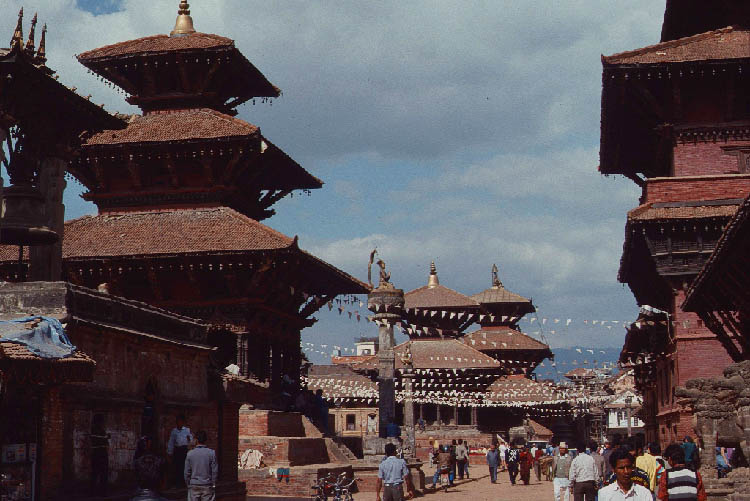
| Another former capital with many temples
|
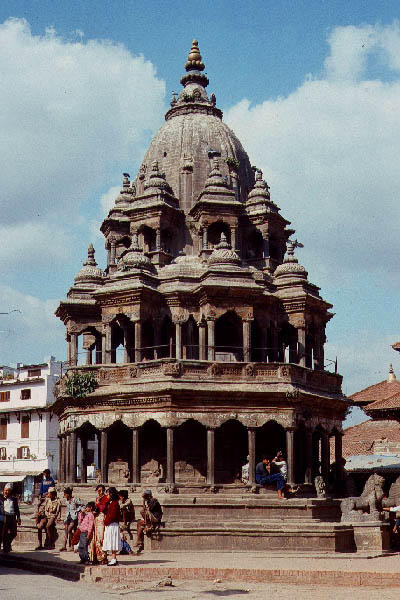
| The Krishna temple, one of nicest temples
|
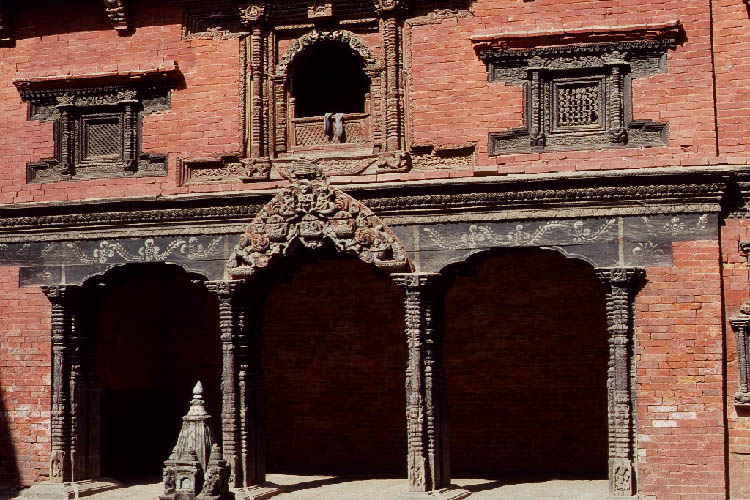
| A house serving the king
|
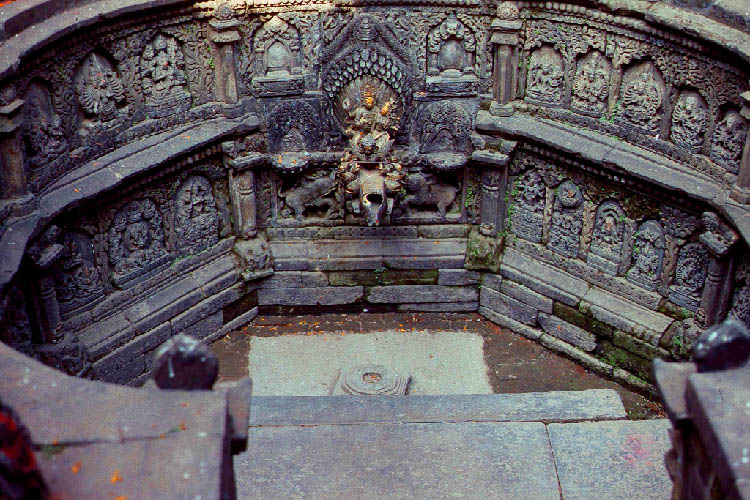
| A fountain for the king?
|
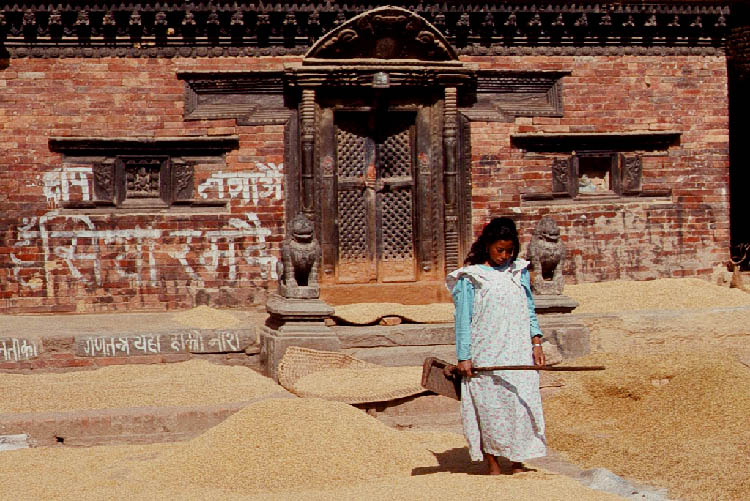
| Drying rice in the middle of town
|
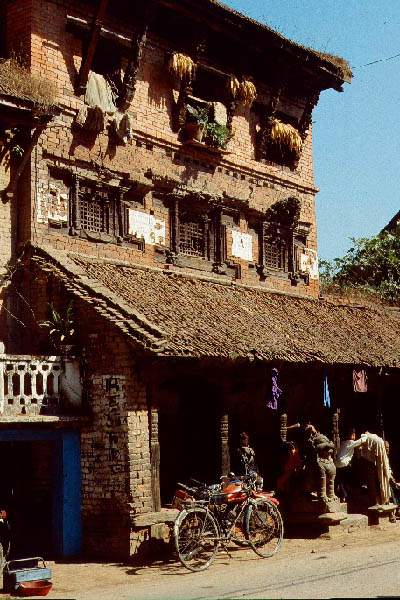
| One of the merchant stores in town
|

| This farm house looks really pretty old
|
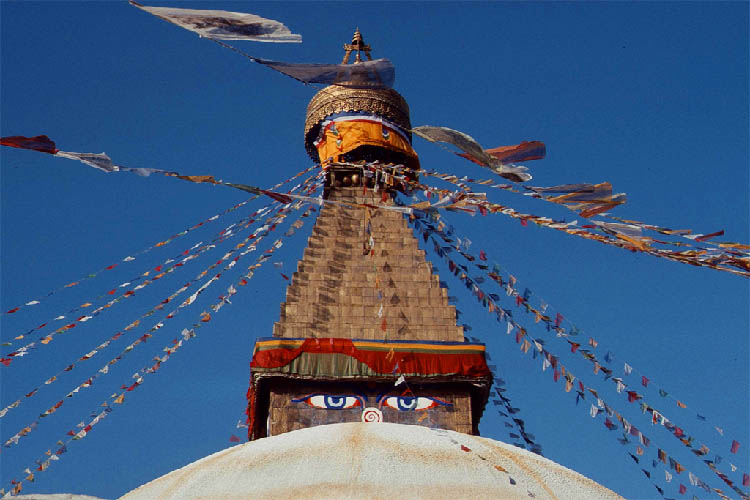
| The top of the stupa contains some gold
|
Then we went to Bodnath with its famous Stupa, the largest in Nepal. It is the religious center of the Tibetans community comprised of many refugees who fled from the Chinese invaders in 1959. This is really one of the few places where Tibetan culture is still thriving. The stupa is surrounded by many large Tibetan houses and many shops selling Tibetan handicrafts. Bodhnath was already a trading post between Lhasa and Kathmandu in the old days.
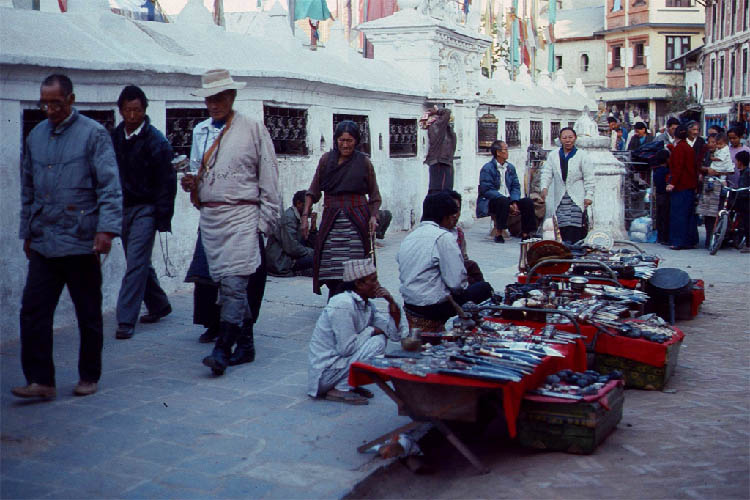
| Now going in circles around the stupa
|
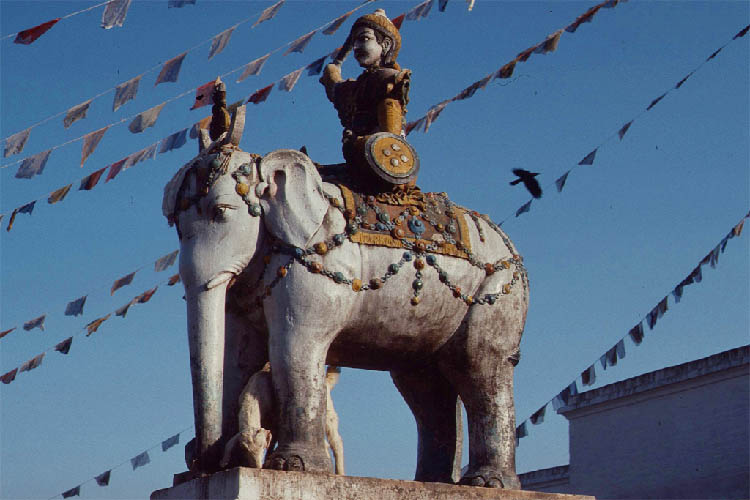
| looking up to an elephant sculptor
|
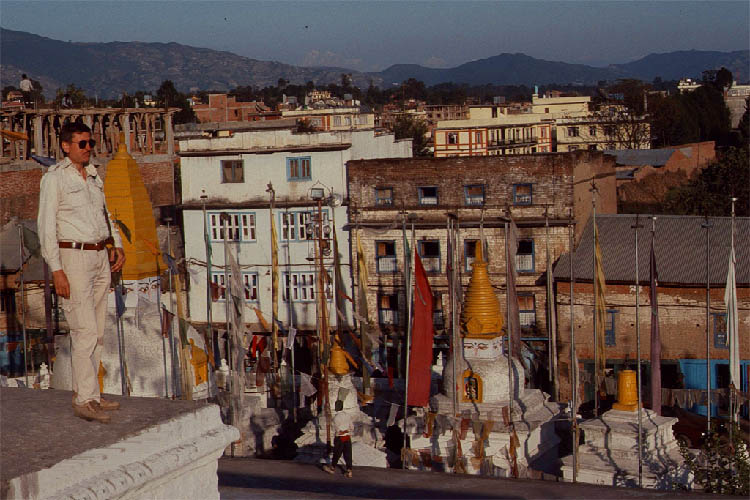
| Looking down onto more small stupas
|
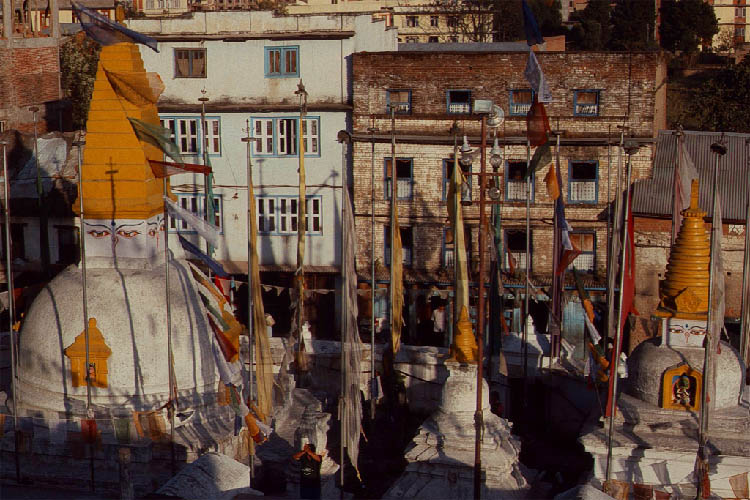
| with the Tibetan flags around the stupas
|
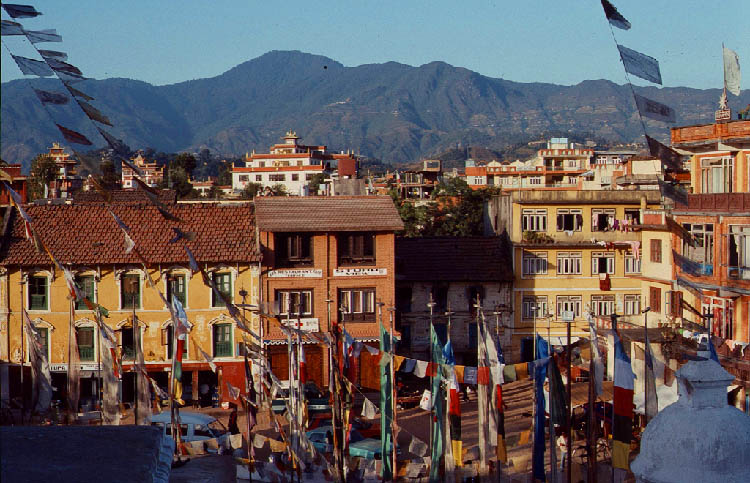
| Not far from here is "Himalaya"
|
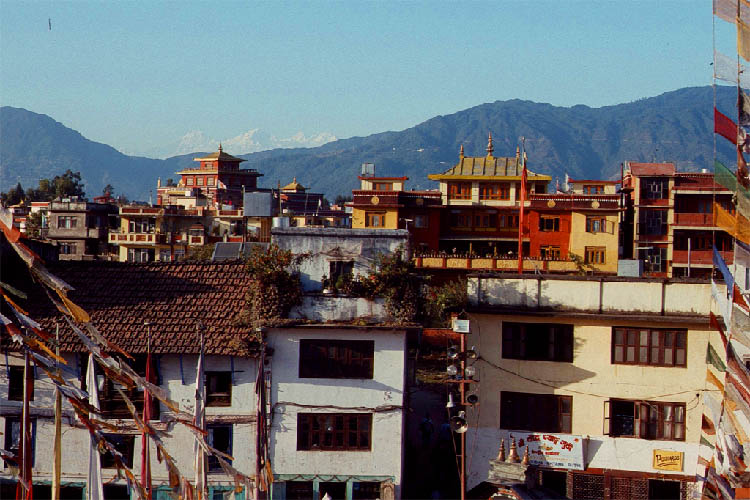
| And behind that must be Lhasa
|
Then came the day we had to leave Kathmandu with a flight to Biratnagar (or was it Dahran Bazar?), the closest airport to the border to India in the east. But that was not so close as expected. No bus around. We were lucky to get a taxi, which we shared with a couple from Germany who also wanted to get to India and then further on to Sikkim, too.
When we arrived at the border it was pretty dark and foggy caused by the smoke of fires burning all around (as a light , for warming, cooking dinner? Who knows). It was a really ghostly situation while we were crossing the border by foot.
Before we could continue with another car, a share-jeep, we had to get our passports stamped by the Indian border control (we already had visas for India). The same night we arrived in the town of Shiliguri, where our Indian trip will commence (see next travel report).
By the way: still at the Kathmandu airport we met the American lady doctor again. Before she was flying off to the Everest Base Camp in Luka, she gave a last advice to Brigitte to use another medication for her ailment. But that was also not the medicine of choice as Brigitte later found out in Sikkim.
Ok, that was Nepal. We could have easily stayed longer and traveled and trekked around more. Also I could have written more. If you want to know more about the place we have visited then just look up any of the many guidebooks or in the internet.
| 

















































































